This Turkish burned pudding recipe shows you step-by-step how to make a vegan kazandibi dessert. Earthy caramel flavors from the flames take this to the next level! It is a dessert fit for sultans.
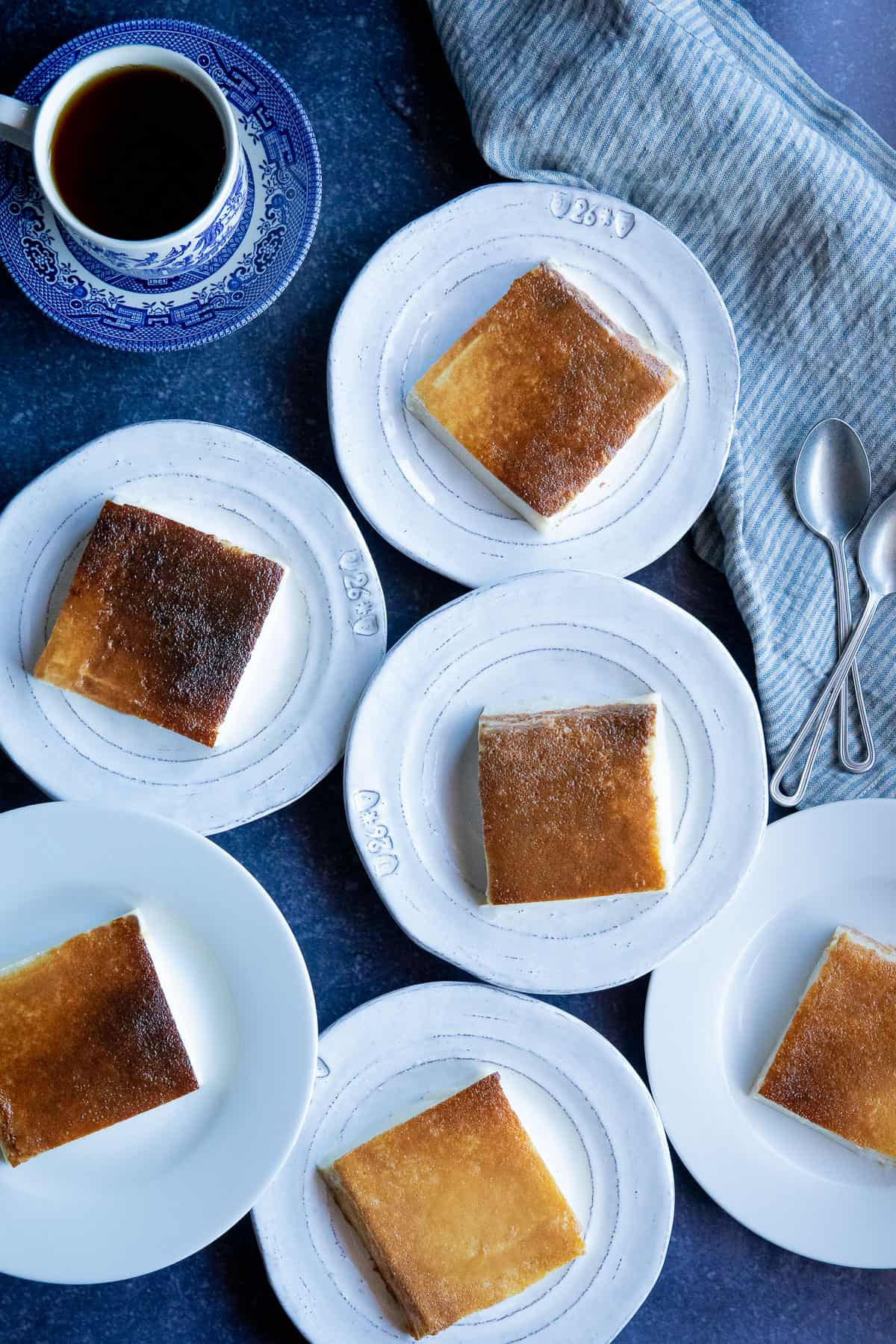
Jump to:
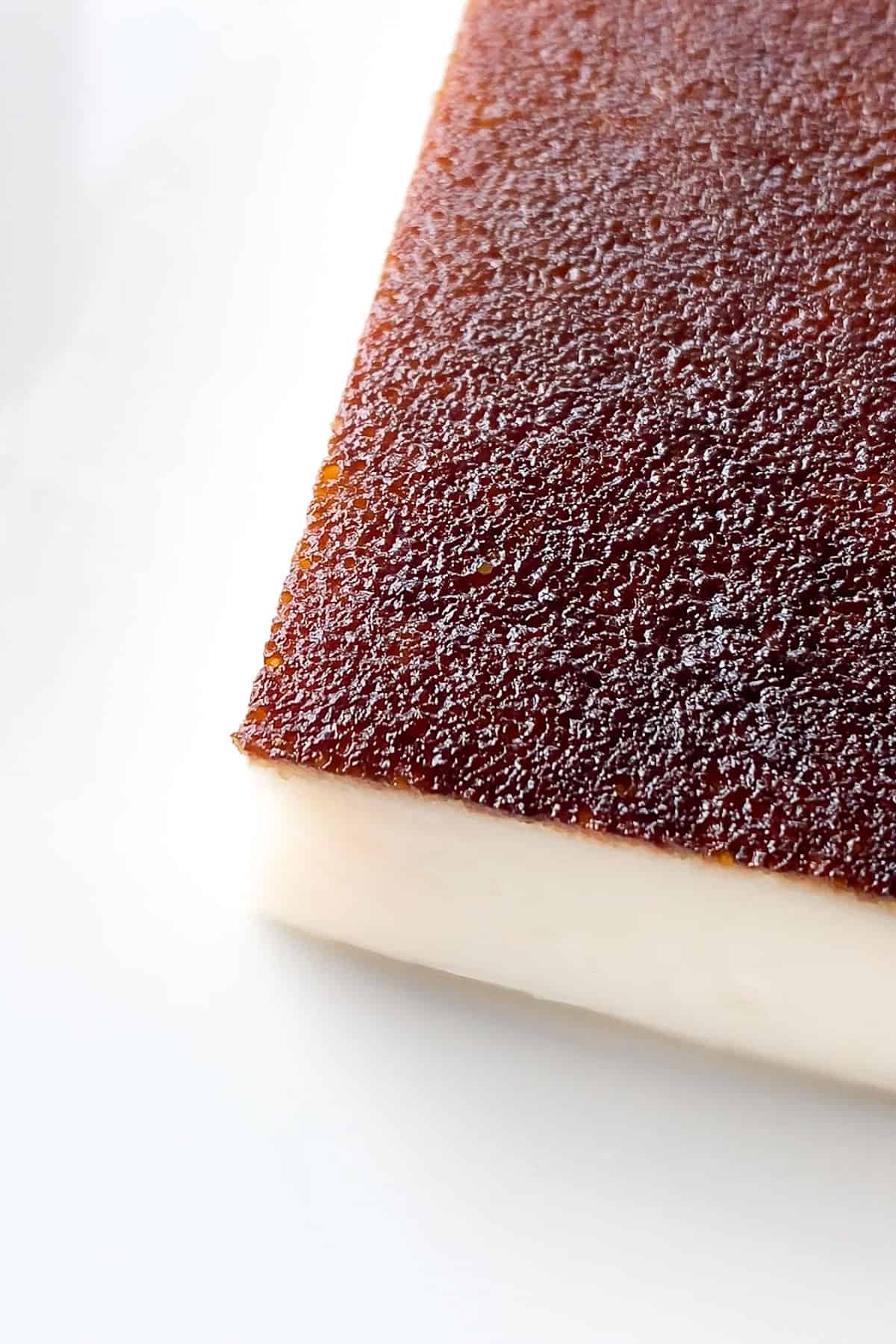
🍮 What is kazandibi?
Kazandibi (kah-ZAHN-dih-BEE) is a Turkish milk pudding dessert with a burnt top layer. It was born in the kitchens of the Ottoman palace centuries ago and is still a very popular dessert in Turkey.
From a myriad of options, kazandibi has been my favorite "milk dessert" (sütlü tatlı) since I can remember. It's richer than regular pudding, almost custard-like; and has an amazing earthy, caramel-like flavor in addition to the freshness of a pudding.
Think of it as a cross between the sensational San Sebastián burned Basque cheesecake, regular vanilla pudding, and crème brûlée. Irresistibly tasty!
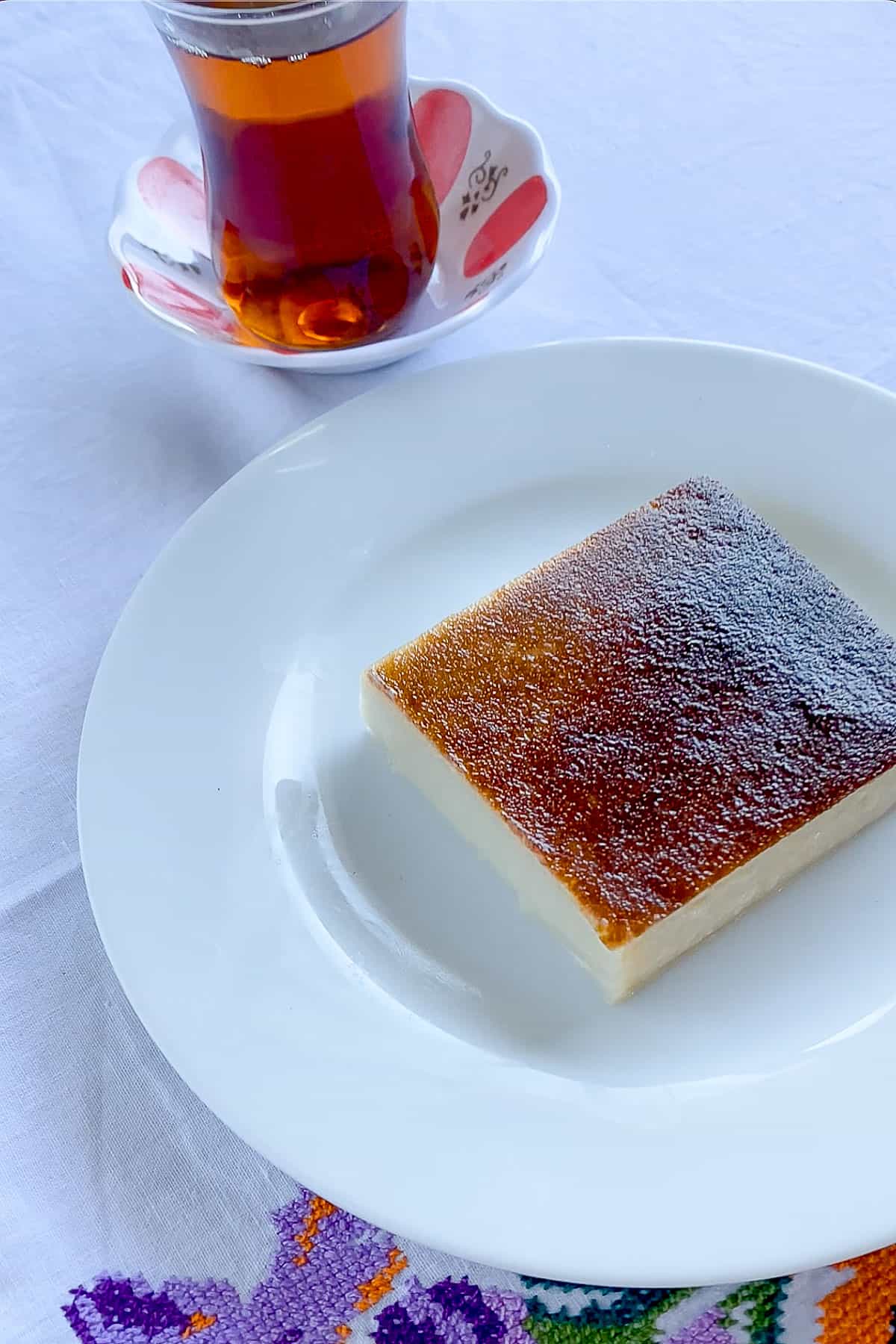
History of the Ottoman burned pudding
In Turkish, kazandibi means "bottom of the cauldron", owing to the unique burnt quality. Legend has it that the dessert came about by accident—akin to other amazing inventions like Coca-Cola or the microwave. Indeed, it isn't difficult to imagine a busy palace chef who forgot his pudding on the stove and ended up loving the result!
Traditional Kazandibi
Authentic kazandibi is made by burning the bottom layer of tavuk göğsü (chicken breast pudding), a dessert made with shredded chicken breast, buffalo milk, and a starch mix called sübye. However, the vast majority of kazandibi currently served in Turkey is made from regular muhallebi (Turkish milk pudding) which lacks chicken breast.
Kazandibi is traditionally not vegan of course, but a huge Turkish pastry chain (Özsüt) has vegan kazandibi made with oat milk on their menu, how exciting!
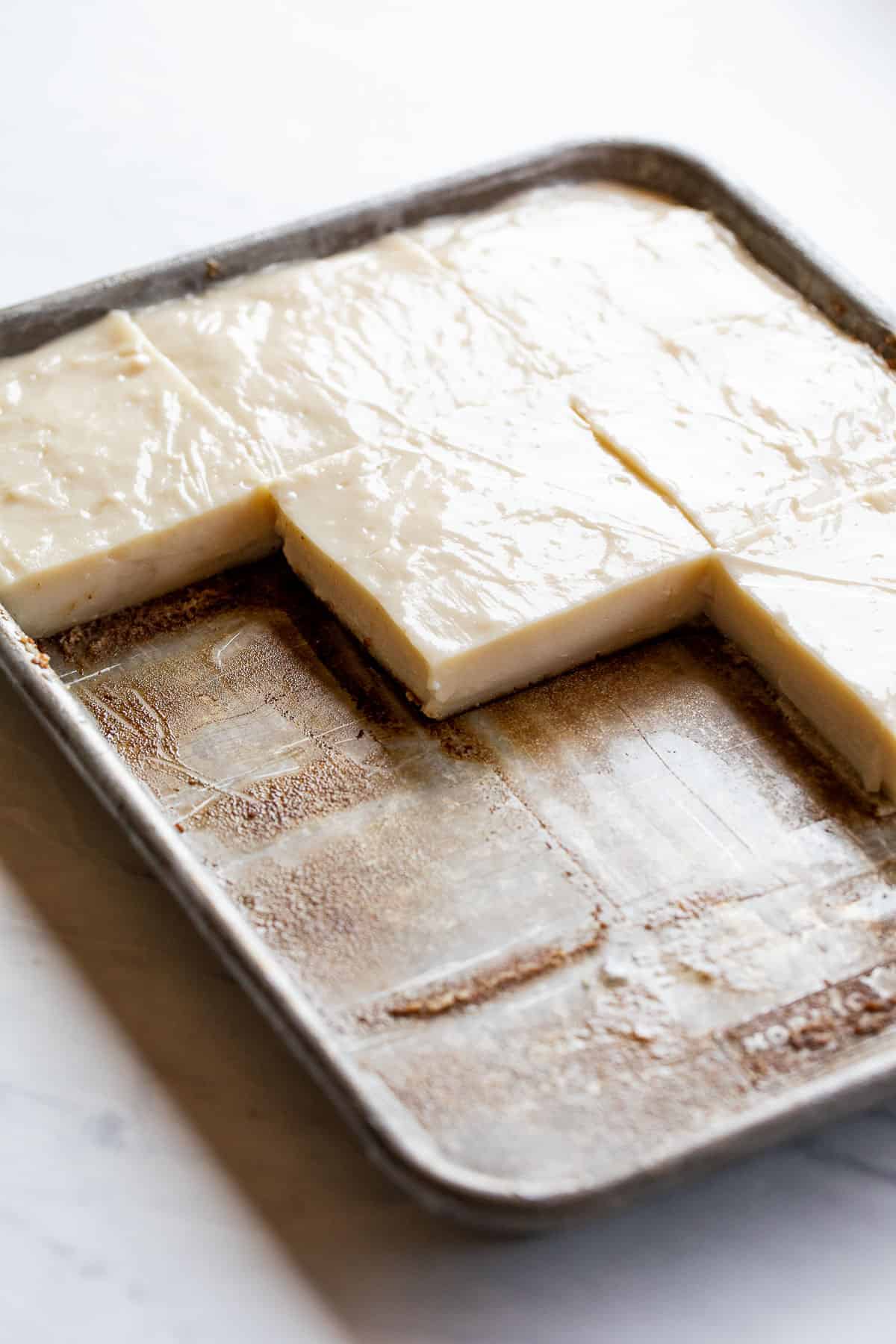
🌟 Why this recipe works...
If you're a fan of custards or puddings in general, this vegan kazandibi can't disappoint. It is flavorful, rich, refreshing, wobbly in the best way, and looks absolutely gorgeous!
A friend who's never seen or heard of this dessert before absolutely loved it when we served it as a tea-time dessert. She described it as "earthy, caramelly, with almost a coffee-like flavor, and unlike anything she's ever eaten before"!
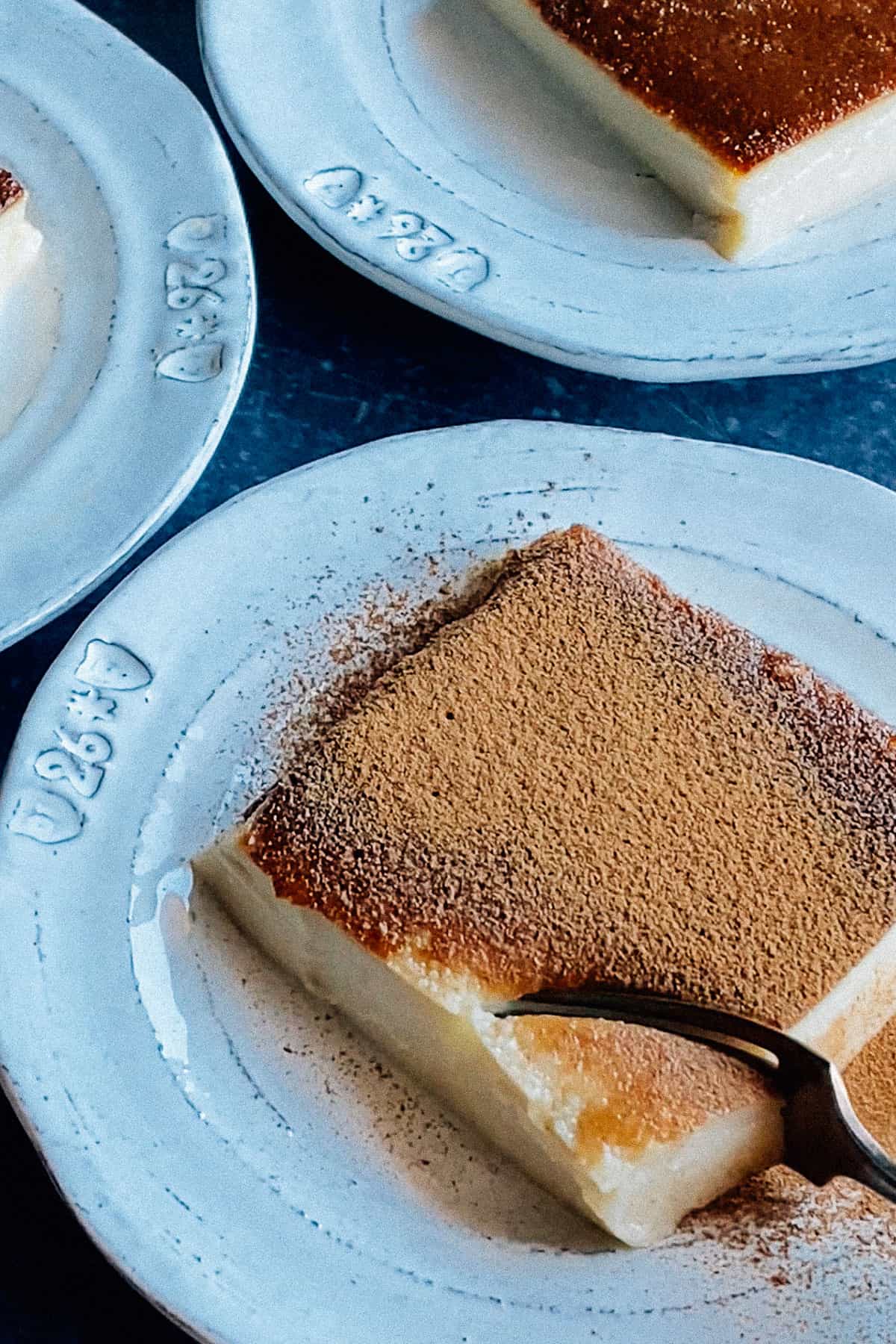
What's more—making it isn't as complicated as it seems. No oven is necessary, and the ingredients are quite forgiving in case you use a different amount than listed. Even the cleanup of the burned tray is a breeze!
🌱 Vegan kazandibi ingredients

Plant Milk
Traditionally, kazandibi is made with whole buffalo milk for the extra fat. To veganize the classic, I tested this recipe with the mixtures of soymilk (plain Westsoy) + coconut cream, as well as oat milk (Trader Joe's) + vegan butter. They both worked, but the flavor of soymilk and coconut cream was superior.
With that said, you can use almost any plant milk you wish—preferably unsweetened and unflavored so as not to complicate the balance of the ingredients. Just make sure to account for the fat content by adding more coconut cream, butter, or coconut oil.
In Turkey, a renowned pastry establishment called Özsüt, founded in 1938, uses oat milk to make their new vegan kazandibi. What a time to be alive!

Starches
Kazandibi was invented back when processed starch products weren't available. Instead, a starch mixture called sübye was used in Ottoman cuisine. Sübye is most popularly made by soaking short-grain white rice in water for 24 hours, then grinding it down to a paste. Virtually freeing up all the starch and making rice flour! We'll bypass that effort by using rice flour instead.
In addition, all-purpose wheat flour is traditionally used in kazandibi. Most modern recipes, including this one, also add cornstarch. You may substitute the cornstarch with rice flour (2 parts rice flour for each 1 part cornstarch) if needed.
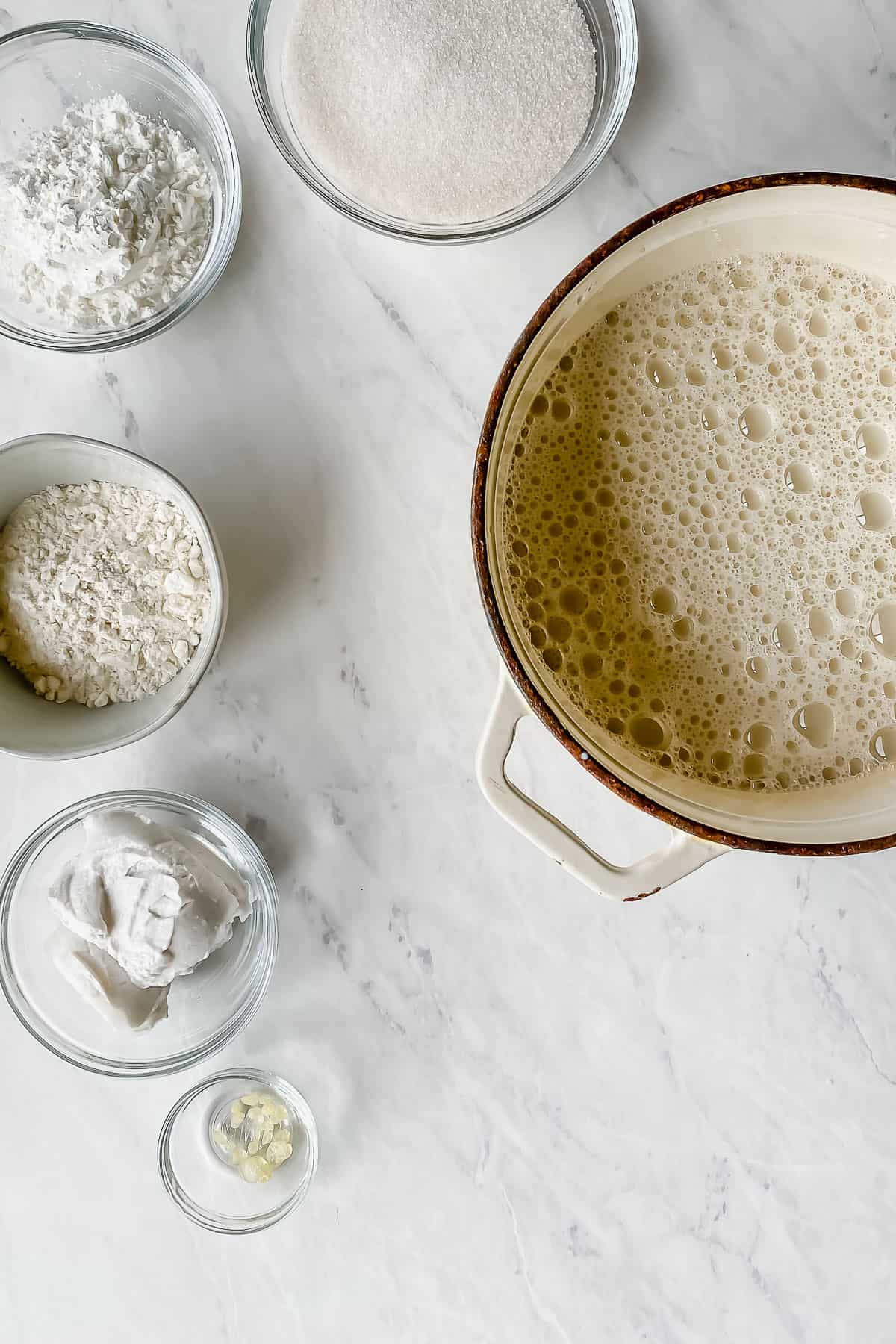
Sugar
I highly recommend using the whitest granulated sugar you can find to achieve that crisp color of traditional kazandibi! If you use organic sugar, it'll be guaranteed vegan 🙂
Regarding the amount—I tested the recipe with ⅔ of the final amount to see if we can get away with using less. We can't. I haven't tested it with alternative sweeteners at all, but feel free to substitute if you must!
Optional
Mastic
A tree resin from the Greek island of Chios, mastic is a very important ingredient in Aegean desserts. Kazandibi isn't traditionally made with mastic, but many shops use just a hint of it to make people go "this has something but I can't put my finger on it 🤔". Well... it's mastic!
You can find mastic at a Greek or Turkish grocery store, or online.
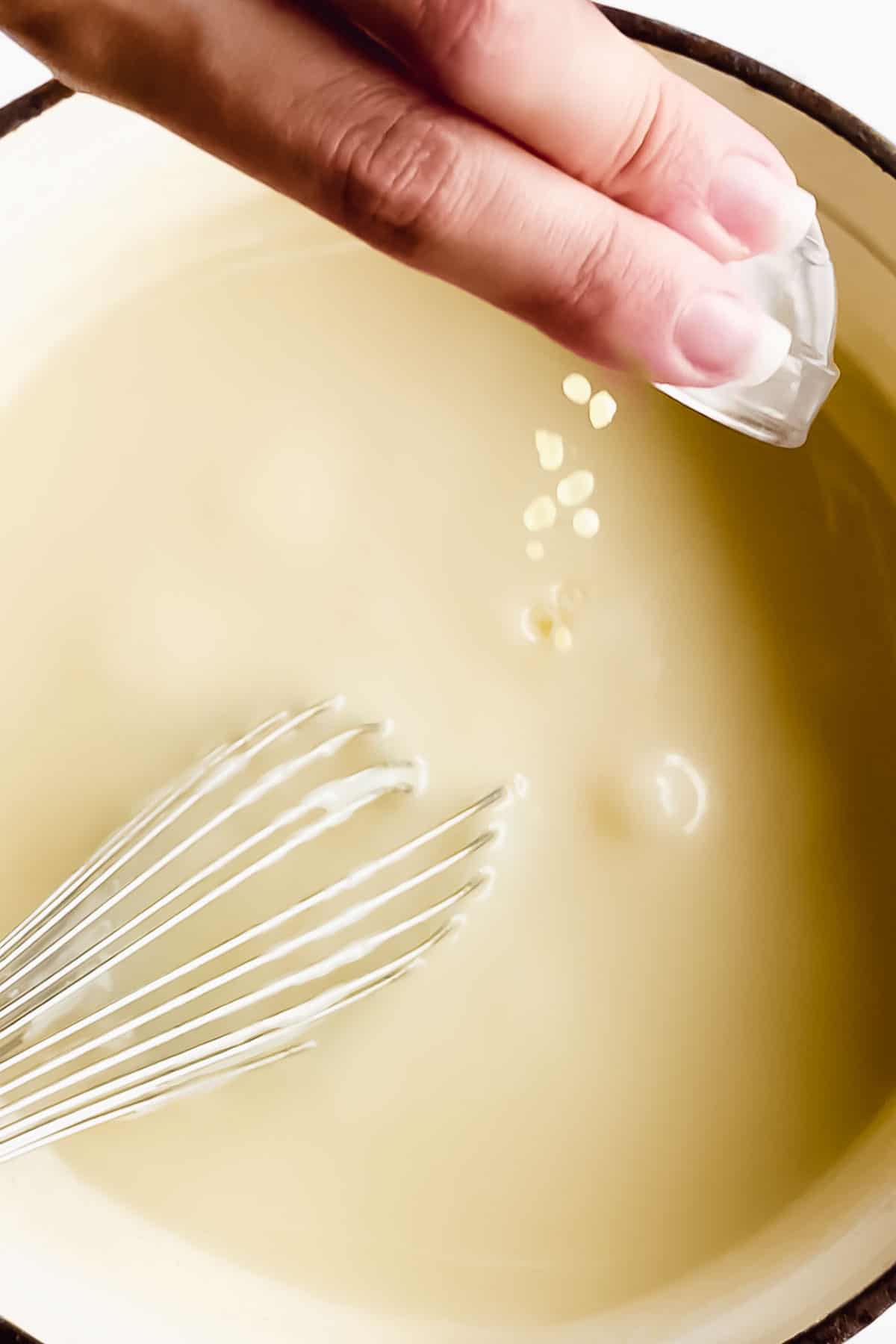
Vanilla
Adding vanilla to an Ottoman dessert is considered a sin by most traditionalists... but it just tastes so good in this recipe! I made one batch with and one without, and my husband and I both agreed that a conservative addition of vanilla extract elevated the recipe.
Cinnamon or Cocoa Powder
Some like to sprinkle one or the other onto kazandibi. I personally like it as is, but keep it in mind as an option!
🥣 Instructions for Turkish burned pudding
Make the Pudding
In a large saucepan, add the cornstarch, rice flour, all-purpose flour, sugar, coconut cream, and milk. Mix thoroughly and heat on medium-high until it comes to a boil, continuously stirring. Once boiling, add the mastic and vanilla (if using) and reduce heat to low. Simmer for 25-30 minutes, stirring occasionally to ensure there aren't any lumps.
Make sure to move to the next burning process quickly, as the pudding will set and may get lumpy the longer it sits.
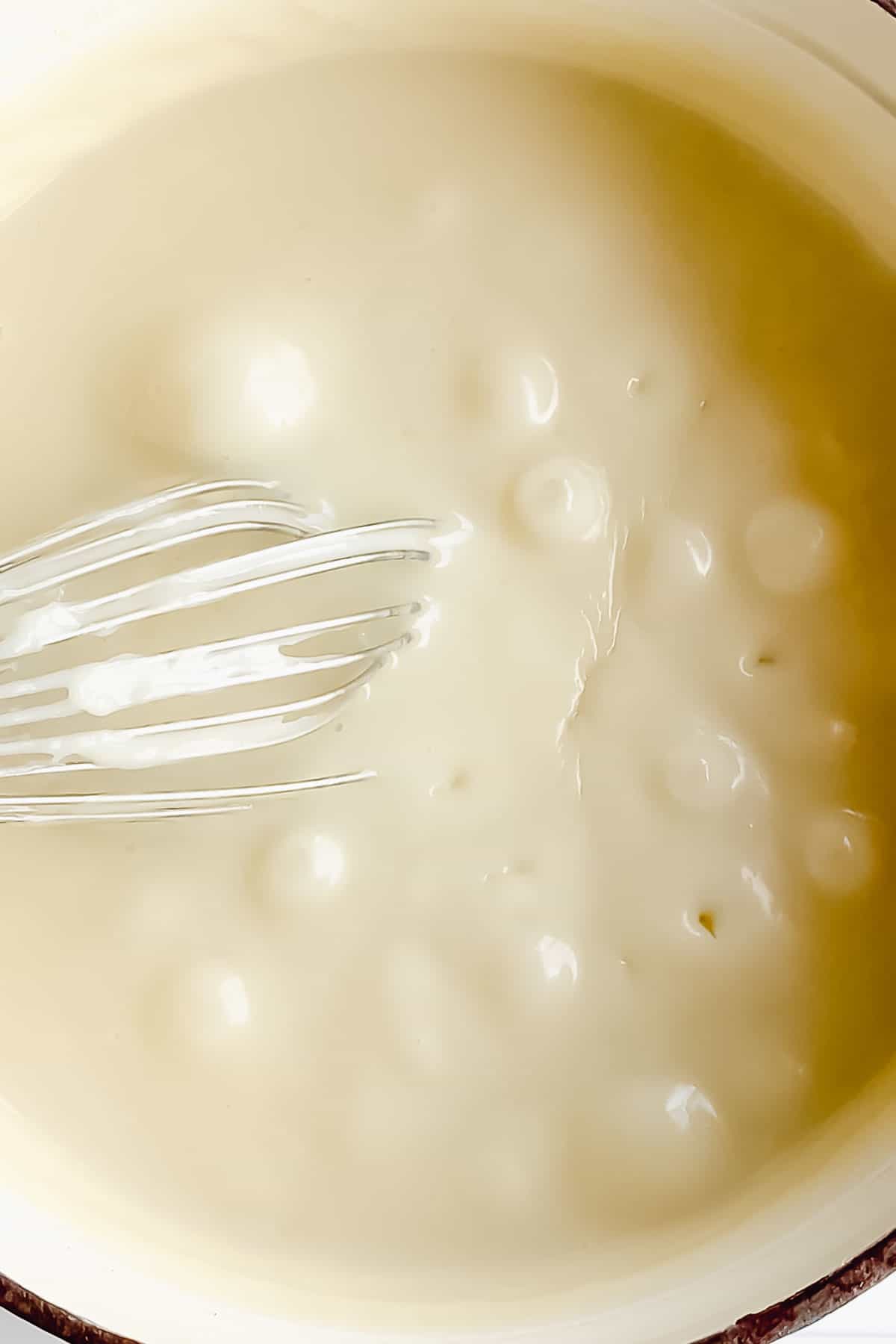
Burn the Bottom
You have two options for achieving the quintessential burned bottom: using a tray (traditional and more fun) or a non-stick pan (easier but gotta be careful not to scratch the coating).
1. Using a Tray over a Flame
You will need a metal baking pan — no enamel or heaven forbid, glass. Aluminum works best. The size of the pan is also very important—the original recipe uses a 9-by-13-inch pan with a 1 ½-inch lip.
You can absolutely use a baking pan (or non-stick pan, below) of a different size, but need to make sure the total area matches up. For example, the original recipe makes a 1-inch-thick tray of pudding, filling up about 120 square inches. If you're using an 8-by-8-inch, (64 square inches) you may simply halve the ingredients and have the same thickness!

Give the tray a quick wash with water right before starting to burn the pudding to make sure the bottom layer doesn't stick. Put the baking pan over a medium-heat burner and place 1-2 cups of the pudding mixture to cover the entire bottom of the pan. Make sure to wear oven mitts, and move the pan around to ensure an even burn.
Use a metal spatula to gently scrape the top to inspect; this will let you see what's happening below the excess pudding. You're looking for a very deep brown, almost black, color all over. The entire process can take 15 to 30 minutes, depending on the level of heat and the material of the pan.
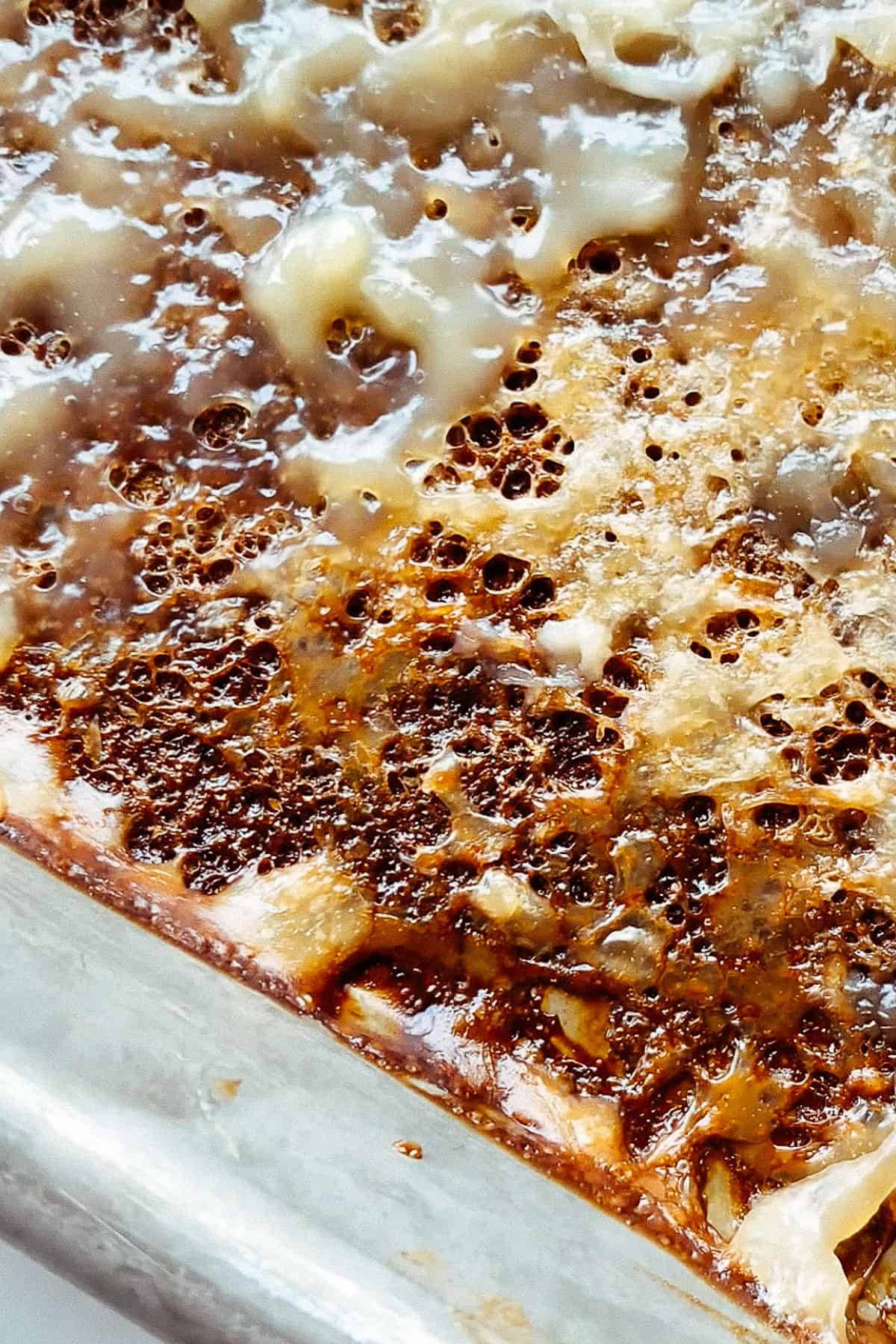
When finished, set the pan aside and add the rest of the pudding mixture over the burned pudding. If there are any lumps, bring the pudding in the pot back to a boil while vigorously mixing, or use an immersion blender. Let cool, then cover and refrigerate for at least 6 hours. Overnight is even better.
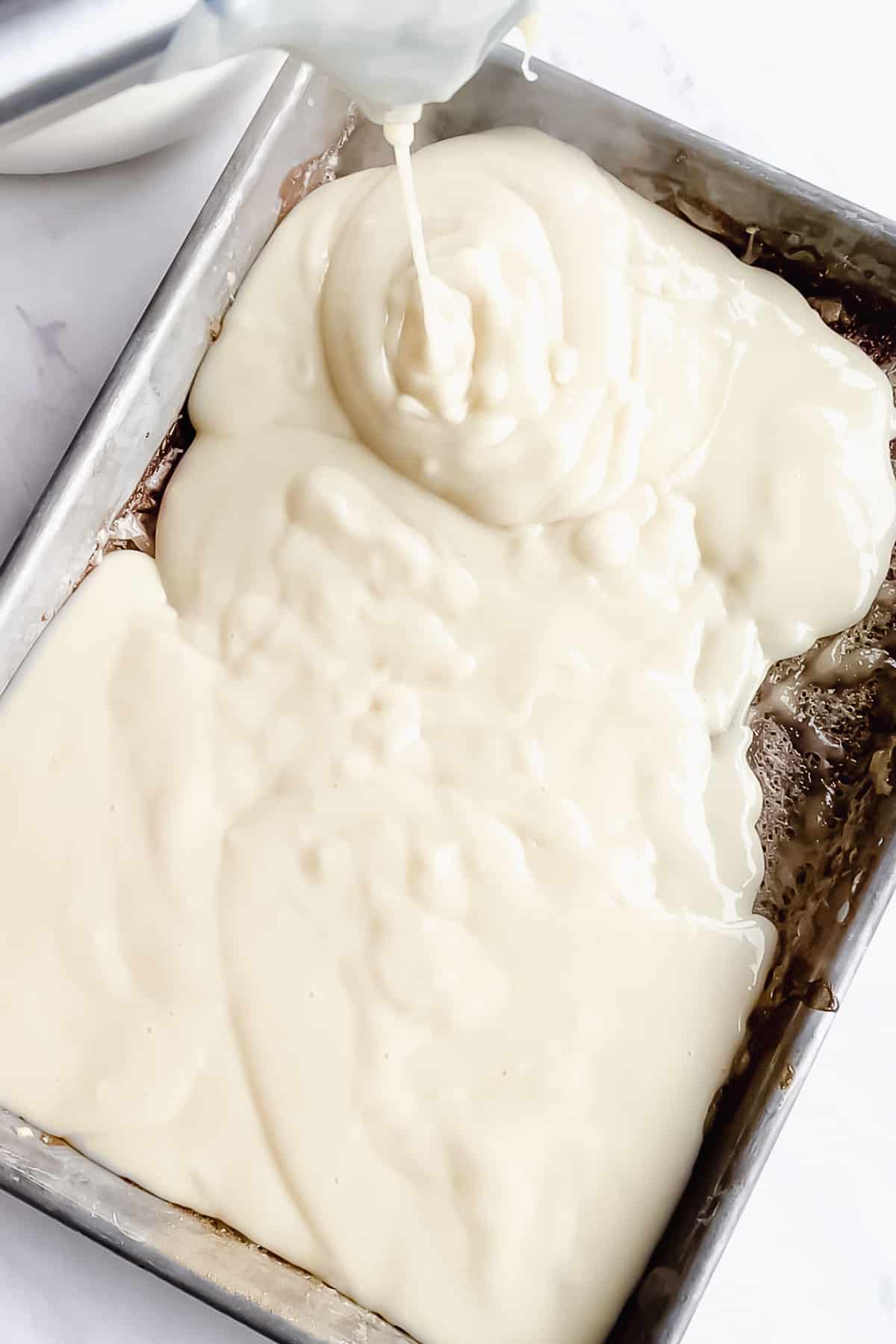
❗️ You do not need to coat the bottom of the tray with butter or sugar! There are some recipes or comments that suggest this (even on Turkish websites)—and it is completely wrong. No pastry shop worth their salt in Turkey uses that technique to make kazandibi. It somewhat alters the authentic earthy flavor and really doesn't make the bottom any less sticky.
2. Using a Non-Stick Pan
Leave it to Turkish women to be practical! This method is a great idea, and makes it somewhat easier to cook kazandibi especially for those with an electrical stove. However, after trying it I thought:
- the process took a lot longer than the first method
- not scratching up the non-stick surface while slicing up took extra work
- the final "burnt" flavor wasn't the same
That's why I would still recommend using a metal tray over the flame to make kazandibi, if you can. If not, simply place a few ladles of the pudding mixture into the non-stick pan and burn the bottom on medium-high heat. Use a silicone spatula to check the bottom; we want it to turn almost black.

...How about just torching the whole thing?
I tried it. The outcomes in both taste and texture are extremely different! Would not recommend.

Serve
Cut the pudding into squares with a spatula, making sure to graze and lift from the very bottom. Serve each slice cold, burned bottom side up, and sprinkled with cinnamon if preferred.
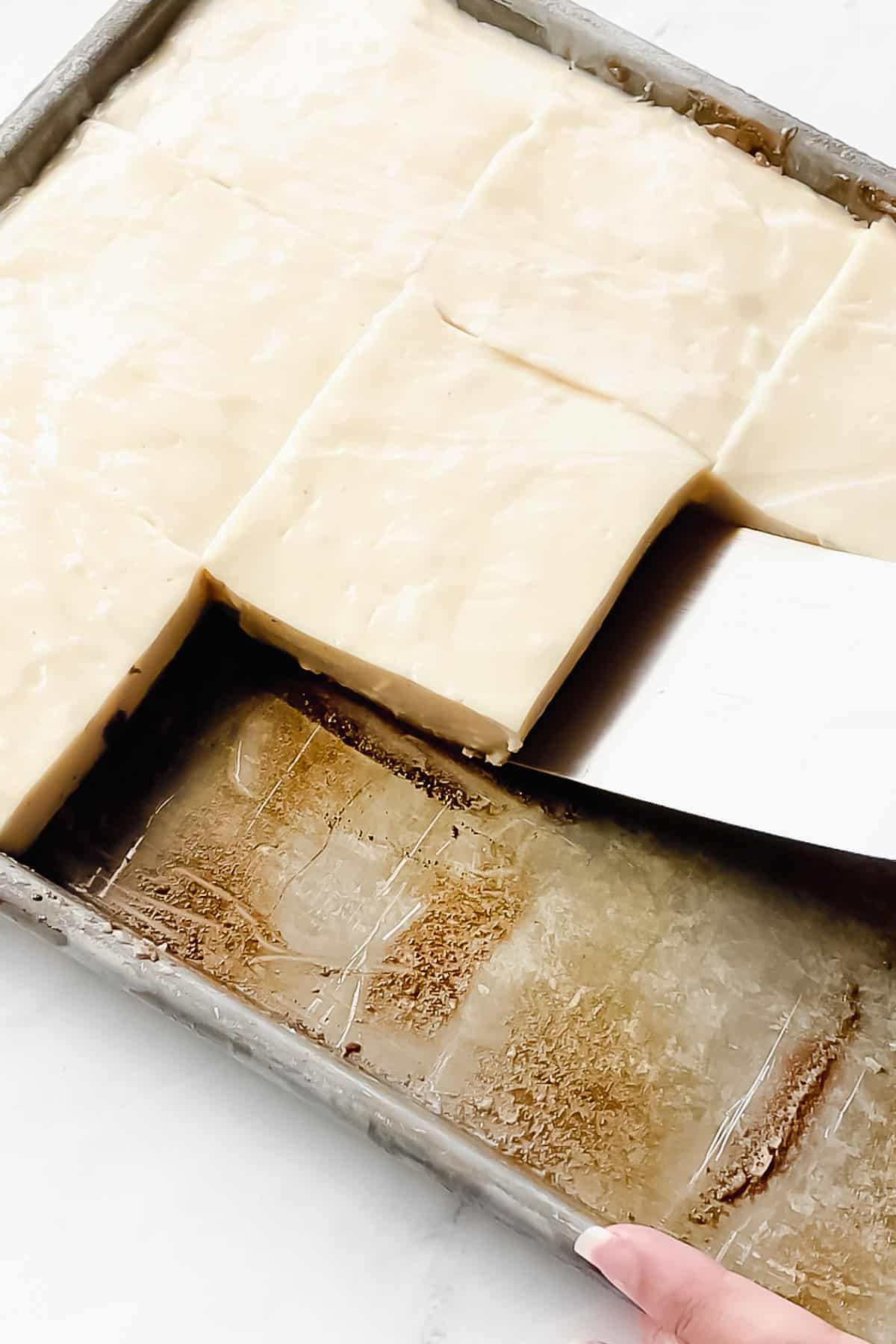
❓Turkish burned pudding FAQs
Kazandibi is richer than regular pudding, almost custard-like; and has an amazing earthy, caramel-like flavor in addition to the freshness of a pudding. Think of it as a cross between the sensational San Sebastián burned Basque cheesecake, regular vanilla pudding, and crème brûlée. Irresistibly tasty!
Kazandibi is a Turkish dessert from the Ottoman palace. Legend has it that the dessert came about by accident—akin to other amazing inventions like Coca-Cola or the microwave. Indeed, it isn't difficult to imagine a busy palace chef who forgot his pudding on the stove and ended up loving the result!
Kazandibi is traditionally made of chicken breast milk pudding that has buffalo milk, rice flour, sugar, chicken breast, and sometimes mastic.
This vegan version is made with plant milk—and of course, without the chicken. I've had the original dessert many times and it tastes pretty much identical to the ones you'd have in Turkey!
In Turkish, kazandibi means "bottom of the cauldron", owing to the unique burnt quality.
The easiest solution is to use an immersion blender! If you don't have one, you could try straining the mixture through a fine-mesh sieve.
Not at all! If you're using an aluminum pan, just soak the surface in water for an hour or two and all the stubborn burned pudding will peel right off.
No. There are some recipes or comments that suggest this (even on Turkish websites)—and it is completely wrong. No pastry shop worth their salt in Turkey uses that technique to make kazandibi. It somewhat alters the authentic earthy flavor and really doesn't make the bottom any less sticky.
The results are vastly different. See the photo in the post for a comparison!
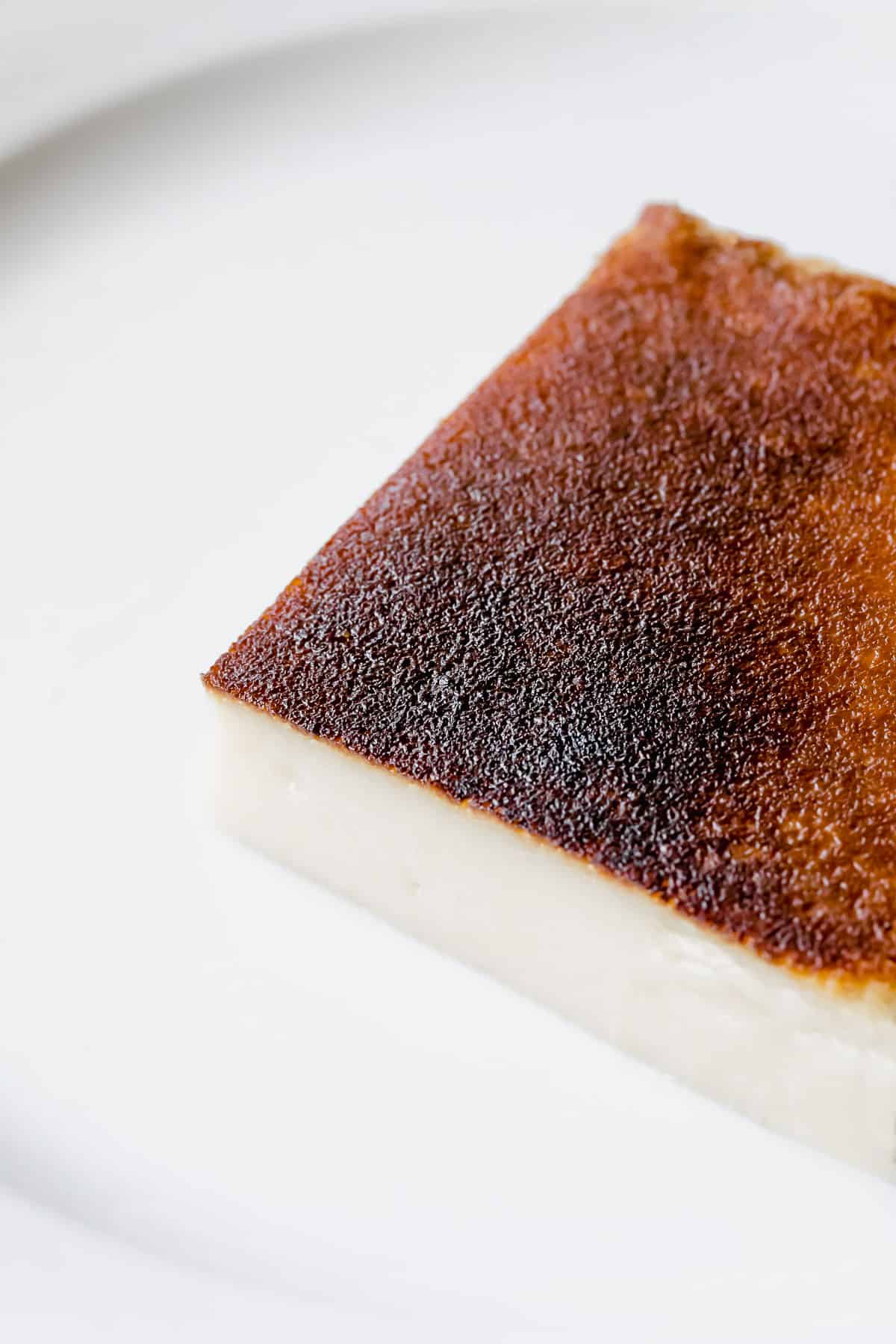
🇹🇷 Other delicious Turkish desserts
Curious about other Turkish gems? Turkish delight is a classic, or try pestil (homemade fruit rollups) for a healthier option. Turkish coffee on the side makes everything even better...
None of these will disappoint!
Did you enjoy this Turkish burned pudding "kazandibi" recipe? I'd love to hear from you! Please comment and leave a "⭐️⭐️⭐️⭐️⭐️" rating below. This helps me sustain Aegean Delight and I greatly appreciate it! 🙏
Print📖 Recipe
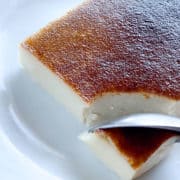
Turkish Burned Pudding (Vegan Kazandibi)
- Total Time: 1 hour + minimum 6 hours' chilling
- Yield: 12 servings 1x
- Diet: Vegan
Description
This vegan burned pudding tastes identical to the authentic Turkish kazandibi dessert. Earthy caramel flavors from the flames take it to the next level! This is a dessert fit for sultans.
Ingredients
For a 9-by-13-inch flame-proof pan (see notes for different sizes)
- ½ cup (60 g) all-purpose flour
- 3 tablespoon (30 g) rice flour
- ⅔ cup (75 g) cornstarch
- 1 ½ cups (300 g) granulated sugar
- 6 ½ cups (1.5 liters) soymilk
- ¾ cup (150 ml) coconut cream
- ½ teaspoon mastic (plant resin), pounded with 1 teaspoon sugar
- optional: ½ teaspoon vanilla extract
Instructions
Make the Pudding:
- In a large saucepan, add the AP flour, rice flour, cornstarch, sugar, soymilk, and coconut cream. Mix thoroughly and heat on medium-high until it comes to a boil, continuously stirring.
- Once boiling, add the mastic and vanilla (if using) and reduce heat to low. Simmer for 25-30 minutes, stirring occasionally to ensure there aren't any lumps.
- Make sure to move to the next burning process quickly, as the pudding will set and may get lumpy the longer it sits.
Burn the Bottom:
- Give the tray a quick wash with water right before starting to burn the pudding to make sure the bottom layer doesn't stick. Put the baking pan over a medium-heat burner and place 1-2 cups of the pudding mixture to cover the entire bottom of the pan. Make sure to wear oven mitts and move the pan around to ensure an even burn.
- Use a metal spatula to gently scrape the top to inspect; this will let you see what's happening below the excess pudding. You're looking for a very deep brown, almost black, color all over. The entire process can take 15 to 30 minutes, depending on the level of heat and the material of the pan.
Set & Serve:
- When finished, set the pan aside and add the rest of the pudding mixture over the burned pudding. If there are any lumps, bring the pudding in the pot back to a boil while vigorously mixing, or use an immersion blender. Let cool, then cover and refrigerate for at least 6 hours. Overnight is even better.
- Cut the pudding into squares with a spatula, making sure to graze and lift from the very bottom. Serve each slice cold, burned bottom side up, and sprinkled with cinnamon if preferred.
Notes
- Pan Size: You will need a metal baking pan — no enamel or glass. Aluminum works best. The size of the pan is also very important—the original recipe uses a 9-by-13-inch pan with a 1 ½-inch lip. You can absolutely use a baking pan (or non-stick pan) of a different size, but need to make sure the total area matches up. For example, the original recipe makes a 1-inch-thick tray of pudding, filling up about 120 square inches. If you're using an 8-by-8-inch, (64 square inches) you may simply halve the ingredients and have the same thickness!
- Non-Stick Pan Method: Place a few ladles of the pudding mixture into the non-stick pan and burn the bottom on medium-high heat. Use a silicone spatula to check the bottom; we want it to turn almost black. This method takes longer (30+ minutes) and the bottom may still not turn the right color.
- Choice of Milk: You may use any plant milk you prefer; unsweetened & unflavored, with no additives will yield the best results. I used Westsoy in which soybeans and water are the only ingredients, and added the coconut cream for extra fat. Keep in mind that classic kazandibi is made with buffalo milk, which is very fatty.
- Gluten-Free: You may substitute the AP flour with store-bought gluten-free flour or rice flour if you wish.
- Mastic: Feel free to skip mastic if you don't have any, the pudding will still turn out delicious! But I'd highly recommend it, you can use mastic in Turkish coffee or ice cream as well.
- Using Sugar to Burn the Bottom: You do not need to coat the bottom of the tray with butter or sugar! There are some recipes or comments that suggest this (even on Turkish websites)—and it is completely wrong. No pastry shop worth their salt in Turkey uses that technique to make kazandibi. It somewhat alters the authentic earthy flavor and really doesn't make the bottom any less sticky.
- Category: Dessert
- Method: Cook
- Cuisine: Turkish



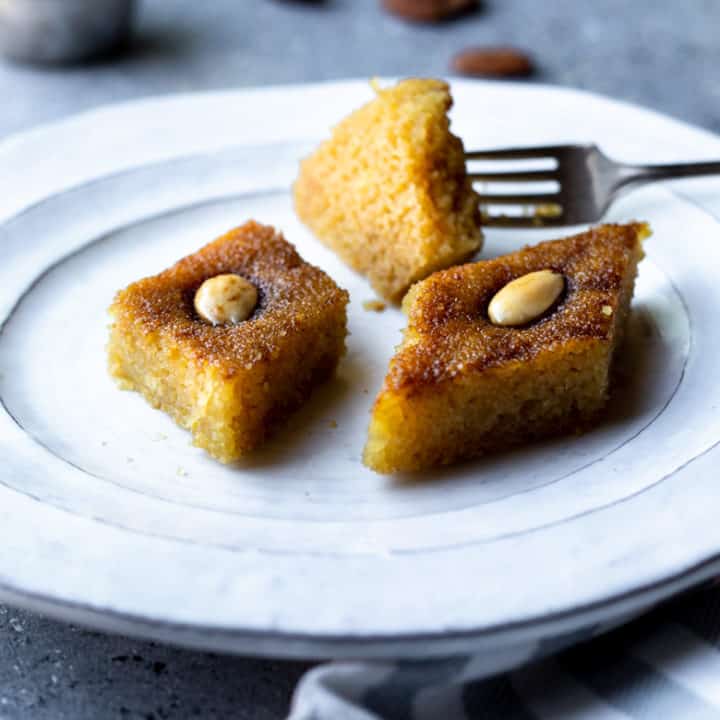

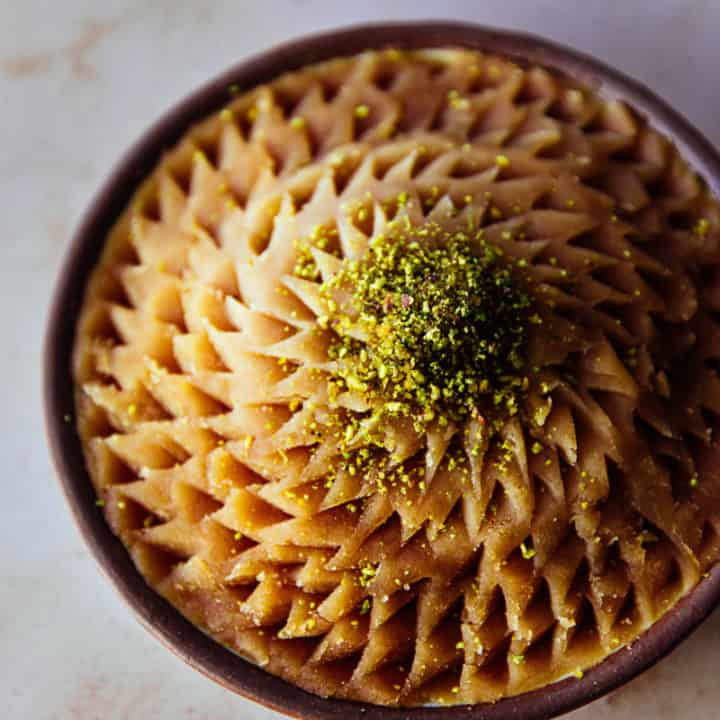
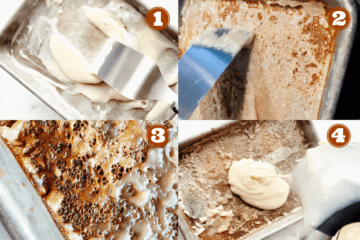


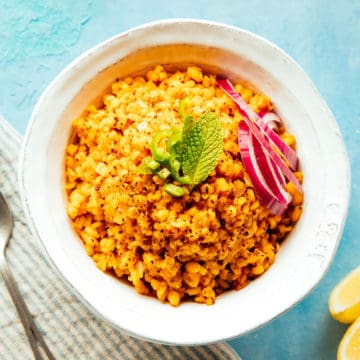
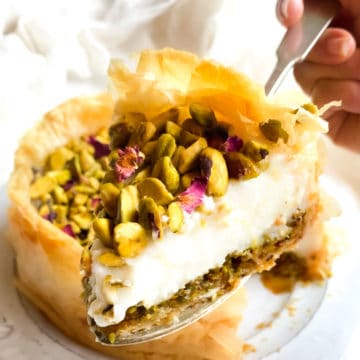
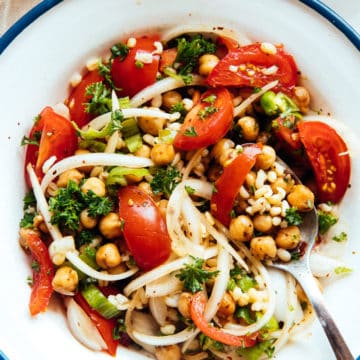
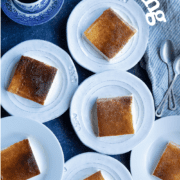
Krista
This looks amazing! Have you had success with gluten free flour?
Gönül
Hi Krista! I haven't attempted this one with gluten free flour yet, but think a store-bought 1 for 1 substitute like Bob's Red Mill or King Arthur GF flour would work well!
You could also try replacing the all-purpose flour with rice flour. Much of the thickening is done by cornstarch anyway, and some versions use solely rice flour.
Hope this helps!
Jordan
Any difference with using an electric burner if I don't have a gas stove with flame?
I was considering placing it close over the bottom element in the oven on a very high temp. Thoughts?
Gönül
The electric burner should work well too! Never made it in an oven but it might be more difficult to frequently check that way… let me know if you’ve ended up trying it either way! Cheers!
Ryan
I had strong doubts that I'd be able to remove the burned layer of the pudding from my frying pan (made it in a cast iron pan), but much to my surprise it worked! My family makes a meal from a different country each Christmas, and this year, it's Turkey. I've tried three different dessert recipes in preparation and until now was despairing of finding one that would satisfy everyone. I've found it in this recipe though. Thanks for offering it!
Gönül
What an incredible tradition!! I might steal this idea 🙂 Glad the cast iron pan worked! Cheers